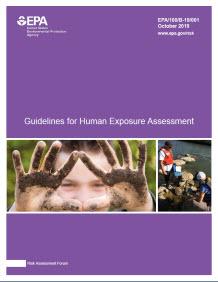 Click to get the reportEPA’s Guidelines for Human Exposure Assessment (hereafter "Guidelines") present the current policies and practices of exposure assessors across the Agency. These Guidelines replace and supersede the Guidelines for Exposure Assessment, which were published in 1992.
Click to get the reportEPA’s Guidelines for Human Exposure Assessment (hereafter "Guidelines") present the current policies and practices of exposure assessors across the Agency. These Guidelines replace and supersede the Guidelines for Exposure Assessment, which were published in 1992.
Updates include a:
- greater emphasis on formal planning, scoping, and problem formulation for exposure assessments;
- advances in the evaluation of exposure data and data quality;
- information on computational exposure models – with a focus on probabilistic models;
- a more rigorous consideration of uncertainty and variability in exposure estimates;
- improvements to communication with stakeholders; and,
- involving tribes in scoping exposure assessments related to tribal concerns.
Guidance is also provided on presenting the results of the exposure assessment and characterizing uncertainty. Although these Guidelines focus on exposures of humans to chemical substances, much of the guidance also pertains to assessing wildlife exposure to chemicals, or human exposures to biological, noise or radiological agents.
Background
The Guidelines include a glossary which helps standardize terminology used by the Agency in exposure assessment. They emphasize that exposure assessments done as part of a risk assessment need to consider the hazard identification and dose-response parts of the risk assessment in the planning stages of the exposure assessment so that these three parts can be smoothly integrated into the risk characterization. The Guidelines discuss and reference a number of approaches and tools for exposure assessment, along with discussion of their appropriate use.
The Guidelines also stress that exposure estimates along with supporting information will be fully presented in Agency risk assessment documents, and that Agency scientists will identify the strengths and weaknesses of each assessment by describing uncertainties, assumptions and limitations, as well as the scientific basis and rationale for each assessment.
References
The Guidelines are intended for risk assessors in EPA, and those exposure and risk assessment consultants, contractors or other persons who perform work under Agency contract or sponsorship. In addition, publication of these Guidelines makes information on the principles, concepts and methods used by the Agency available to all interested members of the public.
These Guidelines supersede and replace the Guidelines for Exposure Assement published on May 29, 1992 (51 FR 22888-22938) (hereafter "1992 Guidelines"). In response to recommendations from the Science Advisory Board (SAB) and the public, the 1992 Guidelines were reviewed and updated in 2016 and then retitled as the Guidelines for Human Exposure Assessment.
You may need a PDF reader to view some of the files on this page. See EPA’s About PDF page to learn more.- Guidelines for Human Exposure Assessment (2019) (PDF)(223 pp, 4 MB, Oct 2019, EPA/100/B-1/001)
